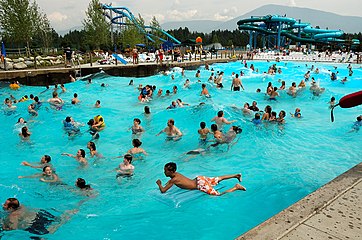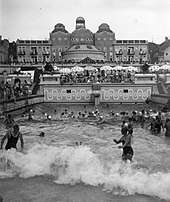Wave pool
A wave pool is a swimming pool in which there are artificially generated, reasonably large waves, similar to those of the ocean. Wave pools are often a major feature of water parks, both indoors and outdoors, as well as some leisure centres.

History

The origins of wave pools go as far back as the 19th century, as famous fantasy castle builder Ludwig II of Bavaria electrified a lake to create breaking waves.
In 1905, the "Undosa" swimming platform was built on Lake Starnberg in Germany, which used large pontoons to force the lake water to make waves. It has since been converted into a restaurant.
In 1912, the "Bilzbad" in Radebeul, Germany was the first public wave pool built on the ground.[1] It used a wave machine, also called "Undosa," first exhibited the previous year at the International Hygiene Exhibition in Dresden.[2][3] It still operates.
Another early public wave pool was designed and built in 1927[4] in Budapest, Hungary in the known Gellért Baths, and appeared one of James A. Fitzpatrick's documentary Traveltalks films about the city in 1938, as one of the main tourist attractions.[5] It remains open.
The natatorium at Bayocean, Oregon also had an early wave-generating machine, before it was destroyed by natural ocean waves in 1932.
In 1929, a Pathe Pictorial there is film of "Indoor Surfers" frolicking in small, artificially-generated waves in a swimming pool in Munch, Germany. The waves were created by agitators which pushed waves through the diving area and into a shallow area - where kids were bodysurfing little waves: "This is the new kind of swimming bath that is becoming the rage of Germany," one of the captions reads. "No more placid waters for bathers - the mechanism behind the netting keeps everything moving."[6]
In 1939, a public swimming pool in Wembley, London, was equipped with machines that created wavelets to approximate the soothing ebb and flowing motion of the ocean. In the 1940s, Palisades Amusement Park, located on the Hudson River Palisades across from New York City, installed a large waterfall at one end of its salt water pool, the largest of such in the world at the time,[7] which generated small waves much like those in Wembley.
In 1966, Akiruno, Japan's "Summerland Wavepool", nicknamed the "Surf-a-Torium", was the first wave pool accessible to surfers (though only for 15 minutes every hour).[1]
Several locations claim to have developed the first wave pool in the United States, including Big Surf in Tempe, Arizona and Point Mallard Park in Decatur, Alabama, which both opened in 1969. The first indoor wave pool in the United States opened in 1982 at the Bolingbrook Aquatic Center in Bolingbrook, Illinois.[8]
In or around 2018 many wave pools opened.[9] The most famous is Kelly Slater's wave pool in California.
Previous claims that Wave pools use fossil fuel and are bad for the environment are not completely accurate. Point Mallard Park Wave pool in Decatur Alabama receives its power from TVA (Tennessee Valley Authority) via Decatur Utilities, which for this location power is generated via Nuclear Reactor at Browns Ferry and Wheeler Dam Hydroelectric plant.[10]
Operation
Wave pools replicate the movement of the ocean one of two ways, depending on the size of the pool and the size of wave desired. In small wave pools, pressurized air is blown onto the surface of the water, or a paddle creates force in the water, creating small ripple-like waves. Other techniques utilize an "accordion mechanism" which opens and closes in order to suck water into its belly (opening) and push it out (closing) to cause waves. However, in high-volume wave pools, a large volume of water is quickly allowed into the far end of the pool, forcing the water to even out, generating a sizeable wave. In these large wave pools, the excess water is removed by being channeled through a return canal where it can be used again to generate another wave.
Types and locations

Generally, wave pools are designed to use fresh water at inland locations, but some of the largest ones, near other seashore developments, use salt water. Wave pools are typically larger than other recreational swimming pools and for that reason are often in parks or other large, open areas.
Some wave pools like those at NLand are expressly designed for surfing rather than for swimming, and accordingly, create much larger waves.
Safety
Wave pools are more difficult to lifeguard than still pools as the moving water (sometimes combined with sun glare) make it difficult to watch all swimmers. Unlike passive pool safety camera systems, computer-automated drowning detection systems do not work in wave pools.
The original eight-foot-deep Tidal Wave pool at New Jersey's recently re-opened Action Park cost three lives in the 1980s, and kept the lifeguards busy rescuing patrons who overestimated their swimming ability. On the first day they officially opened their wavepool, it is said up to 100 people had to be rescued.[11]
Examples
The world's largest wave pool by area is 13,600 square metres (146,000 sq ft) and located in Bangkok's Siam Park City.[12]
The largest indoor wave pool, "Blue Thunder", is 42,000 square feet (3,900 m2) and located at World Waterpark in West Edmonton Mall, Edmonton, Alberta.
The world's largest artificial waves, measuring up to 3 metres (9.8 ft) in height, can be found at Siam Park in the Canary Islands.[13]
See also
Further reading
- Carl Hoffman, "Endless summer", Wired 12.05
References
- Peter Westwick & Peter Neushul, The World in the Curl: An Unconventional History of Surfing
- See de:Bilzbad.
- Volker Helas, Stadt Radebeul, State Office for the Preservation of Monuments Saxony, Radebeul, Federal Republic of Germany, monuments in Saxony. SAX publishing house, Beucha 2007, ISBN 978-3-86729-004-3 , p. 203
- Karpati, Zoltan (1 May 2010). "Gellért Fürdő". Muemlekek.info. Retrieved 16 December 2017.
- "YouTube". Youtube.com. Retrieved 16 December 2017.
- Indoor Surfers! (1929), Pathe Pictorials, YouTube
- "Palisades Amusement Park Historical Society". www.palisadespark.com. Retrieved 2018-07-16.
- "Archived copy". Archived from the original on 2011-07-06. Retrieved 2011-05-19.CS1 maint: archived copy as title (link)
- https://www.surfline.com/surf-news/wavepool-roundup-every-manmade-surf-spot-open-construction-planned/16401. Missing or empty
|title=(help) - https://www.tva.com/energy/public-power-partnerships/local-power-companies/decatur-utilities
- "Archived copy". Archived from the original on 2013-09-03. Retrieved 2013-09-03.CS1 maint: archived copy as title (link)
- "Siam Park City". www.siamparkcity.com. Retrieved 2018-07-16.
- "Siam Park Wave Pool Destination in Tenerife Spain | Surf Park Central". Surf Park Central. 2012-10-19. Retrieved 2018-07-16.